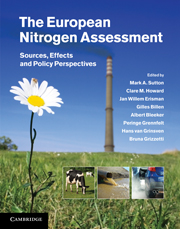Book contents
- Frontmatter
- Contents
- List of contributors
- Foreword
- Summary for policy makers
- Technical summary
- 1 Assessing our nitrogen inheritance
- Part I Nitrogen in Europe: the present position
- Part II Nitrogen processing in the biosphere
- Part III Nitrogen flows and fate at multiple spatial scales
- Part IV Managing nitrogen in relation to key societal threats
- 17 Nitrogen as a threat to European water quality
- 18 Nitrogen as a threat to European air quality
- 19 Nitrogen as a threat to the European greenhouse balance
- 20 Nitrogen as a threat to European terrestrial biodiversity
- 21 Nitrogen as a threat to European soil quality
- Part V European nitrogen policies and future challenges
- Glossary
- Index
- References
18 - Nitrogen as a threat to European air quality
from Part IV - Managing nitrogen in relation to key societal threats
Published online by Cambridge University Press: 16 May 2011
- Frontmatter
- Contents
- List of contributors
- Foreword
- Summary for policy makers
- Technical summary
- 1 Assessing our nitrogen inheritance
- Part I Nitrogen in Europe: the present position
- Part II Nitrogen processing in the biosphere
- Part III Nitrogen flows and fate at multiple spatial scales
- Part IV Managing nitrogen in relation to key societal threats
- 17 Nitrogen as a threat to European water quality
- 18 Nitrogen as a threat to European air quality
- 19 Nitrogen as a threat to the European greenhouse balance
- 20 Nitrogen as a threat to European terrestrial biodiversity
- 21 Nitrogen as a threat to European soil quality
- Part V European nitrogen policies and future challenges
- Glossary
- Index
- References
Summary
Executive summary
Nature of the problem
Atmospheric emissions of nitrogen oxides and ammonia are contributing to a number of negative effects to human health and ecosystems. These effects include both effects of the primary emissions but more importantly through actions of secondary pollutants such as ground level ozone (O3) and secondary particulate matter (PM).
The main air pollution effects include effects of nitrogen dioxide to human health, effects from ground level ozone to human health and vegetation and effects from particulate ammonium and nitrate to human health. There is a difficulty of ascribing health effects to NO2 per se at ambient levels rather than considering NO2 as a surrogate for a traffic-derived air pollution mixture.
Approaches
The chapter gives a brief review of our current understanding of the mechanisms and processes regarding N-containing air pollutants and their effects on human health, vegetation (effects of reactive nitrogen on ecosystems through eutrophication and acidification is treated in Dise et al., 2011; Velthof et al., 2011, Chapters 20 and 21, this volume) and materials. It presents historical development, current situation and outlines future perspectives of reactive nitrogen related air pollution and its effects in Europe in relation to national and EU legislation on emission limitation and air quality control.
Key findings/state of knowledge
In the EU-27 countries, 60% of the population lives in areas where the annual EU limit value of NO2 is exceeded. Air quality standards for nitrogen dioxide are exceeded mainly in urban areas. Concentrations have decreased since 1990, although the downward trends have been smaller or even disappeared after 2000.
[…]
- Type
- Chapter
- Information
- The European Nitrogen AssessmentSources, Effects and Policy Perspectives, pp. 405 - 433Publisher: Cambridge University PressPrint publication year: 2011
References
- 17
- Cited by



